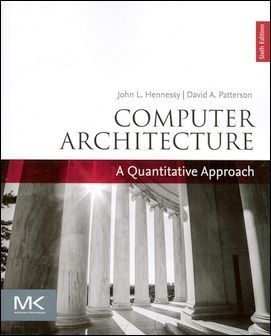Computer Architecture: A Quantitative Approach 6/e
售價
$
3,500
- 一般書籍
- ISBN:9780128119051
- 作者:John L. Hennessy, David A. Patterson
- 版次:6
- 年份:2019
- 出版商:Elsevier B.V.
- 頁數/規格:936頁/平裝單色
- 參考網頁:Computer Architecture: A Quantitative Approach 6/e
書籍介紹
本書特色
目錄
Description
Computer Architecture: A Quantitative Approach, Sixth Edition has been considered essential reading by instructors, students and practitioners of computer design for over 20 years. The sixth edition of this classic textbook from Hennessy and Patterson, winners of the 2017 ACM A.M. Turing Award recognizing contributions of lasting and major technical importance to the computing field, is fully revised with the latest developments in processor and system architecture. The text now features examples from the RISC-V (RISC Five) instruction set architecture, a modern RISC instruction set developed and designed to be a free and openly adoptable standard. It also includes a new chapter on domain-specific architectures and an updated chapter on warehouse-scale computing that features the first public information on Google's newest WSC.
True to its original mission of demystifying computer architecture, this edition continues the longstanding tradition of focusing on areas where the most exciting computing innovation is happening, while always keeping an emphasis on good engineering design.
Computer Architecture: A Quantitative Approach, Sixth Edition has been considered essential reading by instructors, students and practitioners of computer design for over 20 years. The sixth edition of this classic textbook from Hennessy and Patterson, winners of the 2017 ACM A.M. Turing Award recognizing contributions of lasting and major technical importance to the computing field, is fully revised with the latest developments in processor and system architecture. The text now features examples from the RISC-V (RISC Five) instruction set architecture, a modern RISC instruction set developed and designed to be a free and openly adoptable standard. It also includes a new chapter on domain-specific architectures and an updated chapter on warehouse-scale computing that features the first public information on Google's newest WSC.
True to its original mission of demystifying computer architecture, this edition continues the longstanding tradition of focusing on areas where the most exciting computing innovation is happening, while always keeping an emphasis on good engineering design.
Key Features
- Includes a new chapter on domain-specific architectures, explaining how they are the only path forward for improved performance and energy efficiency given the end of Moore’s Law and Dennard scaling
- Features the first publication of several DSAs from industry
- Features extensive updates to the chapter on warehouse-scale computing, with the first public information on the newest Google WSC
- Offers updates to other chapters including new material dealing with the use of stacked DRAM; data on the performance of new NVIDIA Pascal GPU vs. new AVX-512 Intel Skylake CPU; and extensive additions to content covering multicore architecture and organization
- Includes "Putting It All Together" sections near the end of every chapter, providing real-world technology examples that demonstrate the principles covered in each chapter
- Includes review appendices in the printed text and additional reference appendices available online
- Includes updated and improved case studies and exercises
- ACM named John L. Hennessy and David A. Patterson, recipients of the 2017 ACM A.M. Turing Award for pioneering a systematic, quantitative approach to the design and evaluation of computer architectures with enduring impact on the microprocessor industry
Table of Contents
Printed Text
1. Fundamentals of Quantitative Design and Analysis
2. Memory Hierarchy Design
3. Instruction-Level Parallelism and Its Exploitation
4. Data-Level Parallelism in Vector, SIMD, and GPU Architectures
5. Multiprocessors and Thread-Level Parallelism
6. The Warehouse-Scale Computer
7. Domain Specific Architectures
A. Instruction Set Principles
B. Review of Memory Hierarchy
C. Pipelining: Basic and Intermediate Concepts
Online
D. Storage Systems
E. Embedded Systems
F. Interconnection Networks
G. Vector Processors
H. Hardware and Software for VLIW and EPIC
I. Large-Scale Multiprocessors and Scientific Applications
J. Computer Arithmetic
K. Survey of Instruction Set Architectures
L. Advanced Concepts on Address Translation
M. Historical Perspectives and References
Printed Text
1. Fundamentals of Quantitative Design and Analysis
2. Memory Hierarchy Design
3. Instruction-Level Parallelism and Its Exploitation
4. Data-Level Parallelism in Vector, SIMD, and GPU Architectures
5. Multiprocessors and Thread-Level Parallelism
6. The Warehouse-Scale Computer
7. Domain Specific Architectures
A. Instruction Set Principles
B. Review of Memory Hierarchy
C. Pipelining: Basic and Intermediate Concepts
Online
D. Storage Systems
E. Embedded Systems
F. Interconnection Networks
G. Vector Processors
H. Hardware and Software for VLIW and EPIC
I. Large-Scale Multiprocessors and Scientific Applications
J. Computer Arithmetic
K. Survey of Instruction Set Architectures
L. Advanced Concepts on Address Translation
M. Historical Perspectives and References

